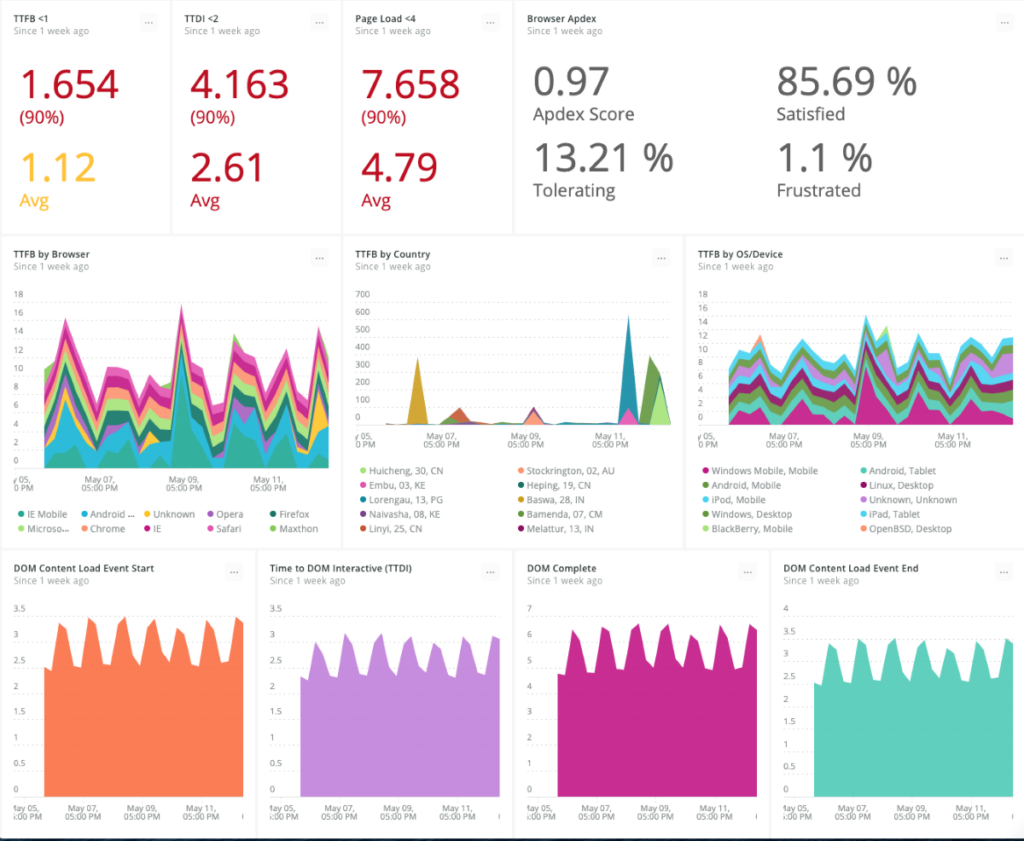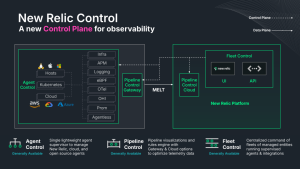Full-stack observability is the practice of monitoring and understanding all layers of a software application, from the front-end user interface to the back-end infrastructure. It involves collecting and analyzing data from various sources to gain insights into an application's performance, availability, and user experience.
In this guide, we’ll further explain full-stack observability and how it differs from monitoring.
Key takeaways:
- Full-stack observability transcends traditional monitoring by providing end-to-end visibility across the entire IT stack.
- Most companies are confusing full-stack observability with individual monitoring tools, causing them to miss out on full IT stack visibility.
- The three essentials of full-stack observability are connected context, a single source of truth, and faster exploration.
- Successful full-stack observability leads to streamlined troubleshooting, improved performance, and better customer experiences, among other benefits.
Most companies aren’t doing observability right
To better understand full-stack observability, let’s imagine a common scenario that plays out regularly at many companies today.
An engineer, Sally, gets a page in the middle of the night about an outage affecting what digital customers experience on the website. Every second counts, but Sally can't tell what the issue is from the information in the pager alert on her mobile phone. So, she rolls out of bed and logs into her performance monitoring tool to find out what’s wrong.
To her surprise, everything she can see without scrolling is showing up with an issue. Every one of the more than 2,000 services for which she’s responsible is appearing red with performance degradation. This is bad—really bad. Sally starts to scroll, but she can’t get an accurate count of how many are affected, nor can she quickly tell if any of these services have something in common, like a cluster, a framework, a team, or related services. She also can’t quickly see what metrics are registering an unusual reading.
So, one by one, she navigates from her application monitoring tool to a log management system to an infrastructure monitoring tool to look for clues and commonalities. She even checks the real user monitoring tool. This is time-consuming, ripe for human error, and turns into a sleepless night for Sally. Not to mention the dissatisfied customers, and money out the door for her employer.
Unfortunately, this is the reality of how many companies experience what they call “observability.” The problem is, they’re confusing monitoring with true observability.
What is full-stack observability?
So let us clarify what we mean when we refer to end-to-end, or full-stack, observability:
Full-stack observability is every engineer’s single source of truth as they troubleshoot, debug, and optimize performance across their entire stack. Users can find and fix problems faster in one unified experience that provides connected context and surfaces meaningful analytics—from logs, infrastructure and applications, distributed tracing, serverless functions, all the way into end-user experience—without having to onboard new tools or switch between them.
Siloed vs. full-stack observability
What many companies are missing is that the experience of observability—full-stack, end-to-end, seeing-the-whole-IT-stack visibility—can’t and shouldn’t be siloed by individual monitoring tools. Developer roles may be consolidating—about 55% of the developers globally who responded to stack overflow's research identified as “full-stack” developers in 2020 vs. 29% in 2015. But a full-stack developer, especially one whose organization has adopted a DevOps culture, is likely using multiple tools with multiple datasets to gain what we at New Relic define as observability: the ability to understand the behavior of your complex digital system.
By “complex digital system,” we mean all the code, all the services, the infrastructure, the user behavior, the logs, metrics, events, and traces you collect from across your entire landscape. Sally’s microservices and distributed systems may give her more agility, scalability, and efficiency for customer-facing applications and critical workloads, but they make it increasingly difficult for her to easily view the big picture and gain true observability.
And organizations aren’t at fault, really—as their entire IT estates grew and became more complex, so did the number of monitoring tools. But none of those tools deliver a single source of truth into the end-to-end performance of the full stack. A UBS Evidence Labreport validates this. Respondents in organizations that have adopted a DevOps culture use an average of four to five tools to perform their job daily—everything from APM to log management to SIEM.

But juggling multiple monitoring tools to get the full picture across your software systems or to find and fix problems creates blind spots, increases toil, and makes it harder to diagnose issues that may be impacting different parts of your estate or multiple layers of your application stack. In short, they gain siloed monitoring, or maybe they call it “observability,” but in our book, it isn’t observability if it isn’t end-to-end observability.
Why is full-stack observability important?
I think we can all agree that none of us want to be in poor Sally’s shoes from our example above. Let’s really hone in on why full stack observability is important:
Quick detection and diagnosis of problems
Full stack observability empowers engineers by giving them the necessary data and insights to diagnose and resolve issues quickly. It helps them to reduce mean time to resolution (MTTR) and minimize downtime, which leads to money savings.
Better context for decision-making
Full stack observability enables teams to have a better understanding of how their systems are functioning in real time, allowing them to make informed decisions on how to optimize and improve their systems.
Proactive approach
With the rise of complex and distributed systems, full stack observability is crucial in providing insights into the interactions between various components, helping teams to proactively address potential issues before they escalate.
Reliability and honesty
Full stack observability enables teams to gain a truthful, holistic view of their entire software stack. It provides transparency into system performance, identifying issues and bottlenecks accurately. This honesty in monitoring helps build trust with users and stakeholders.
Ingenious solutions
It inspires ingenious solutions by revealing unexpected correlations and insights. Observability tools like New Relic can uncover "aha" moments, enabling engineers to explore new paths and optimizations within their systems.
The three essentials of full-stack observability
For our hypothetical Sally engineer, executing on and experiencing this type of observability depends on prioritizing three system attributes:
1. Connected context. When Sally accesses metrics about the health of one of her 2,000 services, she should be able to see how that service affects other services or parts of the distributed system, how those workloads are affected by the Kubernetes cluster that hosts them, and vice versa. And she should be able to understand how the issue between the cluster and the app is affecting the end-user experience on her company’s website, e-commerce portal, or mobile app, all from one system.
Connected context is a reality that learning tools provider Chegg enjoys. It gained a consolidated view of log messages in context with event and trace data to assemble a complete picture of an incident. Regardless of each engineer’s focus, whether back-end, system administrator, or web developer, they need to receive immediate context across a full stack, which depends on the next attribute.
2. A single (open) source of truth. That means one place to store, alert on, and analyze operational data. Sally would need a platform that can ingest metrics, events, logs, and traces from any source, whether from proprietary or open source agents, or via APIs and built-in instrumentation. And that one place would need to be powerful enough to scale for handling the ingest load on her company’s biggest days. Often, companies prioritize only one type of telemetry, such as logs or metrics, or they may sample data from only a subset of systems, applications, or instances. Both lead to holes in observability and slow troubleshooting.
The ops manager at publishing and analytics company Elsevier describes this situation aptly: “I would get a 3 a.m. call about a problem, and the development engineer would tell me the application was performing perfectly, the network engineer would tell me the network was fine, and the infrastructure engineer would tell me that utilization was fine. But things were not fine, and the real challenge stemmed from the fact that they were looking at three different control planes.”
Full-stack observability relies on ingesting any telemetry data you want without worrying how to scale, or building a costly system for peak scale, or swivel-chairing between multiple tools.
3. Easier, faster exploration. So let’s assume Sally’s company gives her a way to ingest all metrics, events, logs, and traces—from anywhere and everywhere across the company’s IT stack. And that the full-stack observability system adds context to that data, so Sally understands interdependencies and up/downstream effects of issues. She’s looking at one screen to see all of this.
Think about that—all performance data on one screen, from everywhere, in real time. That screen needs to have some pretty innovative design. Because for Sally and her team to efficiently traverse large, complex, distributed systems and quickly understand and prioritize any issue, she’ll need intuitive visualizations that require zero configuration. The entire purpose of full-stack, end-to-end observability is to enable engineers to explore and identify system issues in an instant and troubleshoot and fix them before they become a problem for customers. Speed is essential to deliver benefits of lower mean time to resolution and higher uptime. Developers should be able to innovate and chaos test with confidence, knowing that the change they’re making won’t break the system. These are the benefits of full-stack observability.

Sally’s dashboard needs to let her easily explore large systems with point-and-click filtering and grouping for all components that make up her distributed system—applications, infrastructure, serverless functions, third-party integrations, and so on. It shows her where anomalies are occurring, and what changes may be contributing to those anomalies. She immediately sees how issues across the system are related, and any commonalities that exist. Saved views give her team added efficiency and collaboration when troubleshooting. Ultimately, what Sally should see when she awakes from a page at 3 a.m. is an interface so intuitive and modern that it can serve as every SRE’s and IT team’s daily real-time dashboard for understanding what’s happening across their entire environment.
The challenge of full-stack observability for many companies is the aggregation of every type of telemetry data. Engineers love their tools—especially those in a DevOps culture. Any platform delivering end-to-end observability needs to win over engineers and illustrate immediate and greater benefit than their favorite tool. Perhaps promising them more sleep is one way to motivate the change.
Full-stack observability with New Relic
New Relic is here to help businesses achieve seamless full stack observability. Our platform provides a comprehensive view of your entire environment, from applications to infrastructure and everything in between.
With New Relic, you can collect and analyze data in real-time, gain insights into your systems' performance, and proactively identify and resolve issues before they impact your customers.
One of the key benefits of using New Relic for full stack observability is our ability to provide a single source of truth for all your telemetry data. Our platform integrates with hundreds of popular tools and services, allowing you to easily aggregate and visualize all your data in one place. This not only saves time but also eliminates the need for multiple monitoring tools.
Learn more about how to gain full-stack observability from consolidating tools.
이 블로그에 표현된 견해는 저자의 견해이며 반드시 New Relic의 견해를 반영하는 것은 아닙니다. 저자가 제공하는 모든 솔루션은 환경에 따라 다르며 New Relic에서 제공하는 상용 솔루션이나 지원의 일부가 아닙니다. 이 블로그 게시물과 관련된 질문 및 지원이 필요한 경우 Explorers Hub(discuss.newrelic.com)에서만 참여하십시오. 이 블로그에는 타사 사이트의 콘텐츠에 대한 링크가 포함될 수 있습니다. 이러한 링크를 제공함으로써 New Relic은 해당 사이트에서 사용할 수 있는 정보, 보기 또는 제품을 채택, 보증, 승인 또는 보증하지 않습니다.



